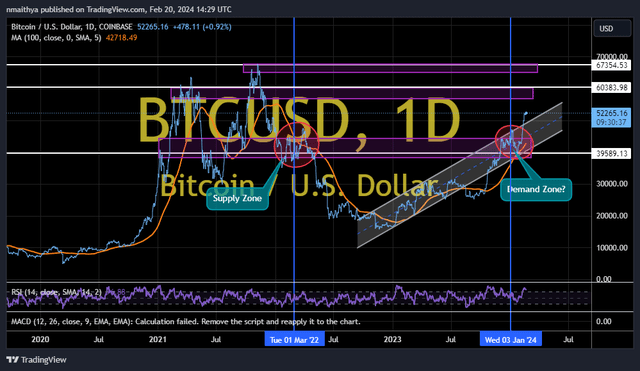

Ismagilov
Bitcoin (BTC-USD) is scheduled to undergo its fourth halving in April, one of the most anticipated events of 2024 in the cryptocurrency space.Halving is the process by which the amount of Bitcoin mined is reduced by half, thereby reducing the number of new Bitcoins released. market.
This policy was introduced to ensure that Bitcoin remains scarce. According to the Blockchain Council, approximately 2 million Bitcoins remain to be mined. As of 2023, approximately 19 million coins have been mined, and the maximum supply is capped at 21 million coins.
Investors typically target the period leading up to the next Bitcoin halving to buy more Bitcoin in anticipation of a post-halving rebound.
According to statistics, the price of Bitcoin against the US dollar sharp rebound After the previous three halvings. Within six months of the first halving in 2012, BTC price increased by 950% against the US dollar, jumping from $12 to $126.
After the second halving in 2016, the price rose from $654 to $1,000 in seven months, while during the same period in 2020, the price surged from $8,570 to $18,040.
The first three halvings all had more potential catalysts for price increases.
The first Bitcoin halving occurred in November 2012, following the launch of Litecoin in October 2011 and Peercoin in August 2012. The two issuances mark the growing momentum of cryptocurrency adoption, which, coupled with Bitcoin’s increasing rarity, may have contributed to the Bitcoin halving. BTC/USD price surges.
When the 2016 halving occurred, Ethereum had just launched the year before, introducing a new perspective to the cryptocurrency. Now, developers can build their own applications on the blockchain, further diversifying the cryptocurrency’s use cases. This was also a time when Initial Coin Offerings (ICOs) were becoming increasingly popular, making it easy for almost anyone who wanted to explore opportunities in the industry to raise funds for their projects.
With the 2020 halving, the blockchain industry has begun to integrate into the mainstream through decentralized finance, blockchain games, and non-fungible tokens, all of which may also have pushed up the price of BTC.
We are witnessing a similar development, with recent spot Bitcoin ETFs likely to fuel a fourth post-halving rally in price.
The case for buying Bitcoin ahead of the April halving
Bitcoin prices are up 17.65% this year, driven by the SEC’s approval of a spot Bitcoin ETF. This SEC decision creates a major avenue for traditional investors to invest in Bitcoin without creating a cryptocurrency wallet.
One of the biggest barriers to entry into the cryptocurrency industry is the complex features that users must become familiar with before investing. While some companies are trying to streamline the process with cryptocurrency on-ramps (allowing people to buy cryptocurrencies using fiat currency), it’s still not as smooth sailing as depositing money into a mobile wallet.
Allowing traditional investment banking institutions to offer spot Bitcoin ETFs, allowing non-cryptocurrency local investors to invest in the world’s most popular cryptocurrency just like buying shares in other ETFs.
This paves the way for more capital to flow into Bitcoin, further boosting its demand. According to Barron’s, BlackRock’s iShares Bitcoin Trust has raised more than $5.2 billion since its launch, while the Fidelity Wise Origin Bitcoin Fund has exceeded $3 billion. These numbers represent only two of the 13 spot Bitcoin ETFs approved in January 2024.
But that’s not the only catalyst that could push Bitcoin prices higher in the coming months. I reached out to some experts in the cryptocurrency space to find out how much impact the Bitcoin halving and spot ETF approval will have on the BTC/USD price.
Saul (Shauli) Rejwan, founder and managing partner of Masterkey VC, believes the approval of the ETF is an important step towards regulatory approval and legality for the crypto industry.
“Bitcoin ETFs demonstrate the interest of traders and institutional investors in allocating funds to Bitcoin using traditional trading and investing methods. Demand has exceeded expectations, with more than $10 billion flowing into the market last month alone,” Rejwan said.
Brandon Dallmann, co-founder of blockchain consultancy and advisory firm RoundTable21, also believes that the approval of the ETF breaks the final barrier for Bitcoin as a global reserve asset.
But more importantly, he believes that the halving occurs at a time when the Bitcoin mining network does not have to exploit energy and the global power grid.
“We are already seeing pioneer power companies deploy mining contracts to improve grid efficiency, reduce energy waste and use it to economic advantage.”
Dahlman said that when deployed strategically, Bitcoin infrastructure can be “used to tactically expand and strengthen global energy providers, providing countries that utilize Bitcoin a strategic computing advantage over those that do not.” Bitcoin has never taken advantage of this opportunity for any other halving in its history. “
One of the biggest criticisms leveled at Bitcoin is the amount of electricity required to mine one Bitcoin. 2021, “The New York Times” estimated This figure is approximately 155,000kWhm, equivalent to more than 14 years of electricity consumption by the average American household. This fact prevents certain groups of people, especially those concerned about climate change, from investing in Bitcoin.
However, as companies find new ways to use Bitcoin mining to optimize the economic value of the electricity they produce, this could further serve as another catalyst for a post-halving Bitcoin price increase.
Recently, the Bitcoin ecosystem has also become one of the fastest growing decentralized application (dApp) blockchains, following in the footsteps of popular dApp networks such as Ethereum and Solana.
The Bitcoin blockchain is now more than just a cryptocurrency, it adds to Bitcoin’s use cases. This is the first Bitcoin halving since the Bitcoin network has undergone a major evolution.
Technically, Bitcoin also appears poised to continue its current rally after hitting a fresh 27-month high of $52,265 against the U.S. dollar on Tuesday.

trading view
Bitcoin price recently completed an upward breakout from an ascending channel, showing that bullish momentum is accelerating. Furthermore, Bitcoin is now overbought on the 14-day RSI, further supporting the bullish bias.
The pioneer cryptocurrency’s price is also supported by the 100-day moving average, which triggered the latest surge.
The next key resistance zone lies near the $60,000 level, a break above which could pave the way for a rebound that could push BTC/USD to new all-time highs.
The $40,000 level, which was previously an area of supply, is now emerging as an area of strong demand, allowing investors to use it as a potential area to purchase more Bitcoin if a major pullback occurs.
The case for not buying Bitcoin before the halving
Although Bitcoin is quickly emerging as a potential reserve currency, cryptocurrencies still represent a relatively small asset class compared to other popular investment vehicles.
Rejwan said: “The total digital asset trading volume is about $2 trillion, while the derivatives market is worth over $250 trillion, gold is about $10 trillion, and bonds and stocks are over $100 trillion.” Compared to these asset classes, this makes Bitcoin becomes a relatively risky asset.
Additionally, recently launched spot Bitcoin ETFs may suffer from recency bias that may dissipate over time, limiting their potential impact on Bitcoin price.
While the past three halvings have proven that they can drive Bitcoin prices higher, things may be different this time.
First, investors are now smarter and will buy Bitcoin months before the halving. The recent surge in Bitcoin/USD may support this scenario, suggesting that the expected post-halving rally may already be priced in.
Second, Bitcoin regularly retraces after every major rally. Since falling below $20,000 in January 2023, Bitcoin has gained more than 200%. Moreover, since March of the same year, the retracement range has not exceeded 15%, and there has been no rebound.
Therefore, BTC/USD is still likely to experience a significant squeeze of around 23%, which could retest the $40,000 level, which now represents a key demand area.
in conclusion
Overall, there are multiple catalysts for Bitcoin’s continued bull run. The opportunities created by the approval of spot Bitcoin ETFs and the emergence of the Bitcoin network as a dApp ecosystem make Bitcoin a more interesting cryptocurrency ahead of the fourth halving.
Technical analysis also supports a continuation of the current rally, with the $60,000 level likely to provide a signal of how far this rally could go.




